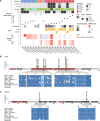Comprehensive multiomics analysis reveals distinct differences between pediatric choroid plexus papilloma and carcinoma
- PMID: 38867333
- PMCID: PMC11167863
- DOI: 10.1186/s40478-024-01814-y
Comprehensive multiomics analysis reveals distinct differences between pediatric choroid plexus papilloma and carcinoma
Abstract
Choroid plexus tumors (CPTs) are intraventricular tumors derived from the choroid plexus epithelium and occur frequently in children. The aim of this study was to investigate the genomic and epigenomic characteristics of CPT and identify the differences between choroid plexus papilloma (CPP) and choroid plexus carcinoma (CPC). We conducted multiomics analyses of 20 CPT patients including CPP and CPC. Multiomics analysis included whole-genome sequencing, whole-transcriptome sequencing, and methylation sequencing. Mutually exclusive TP53 and EPHA7 point mutations, coupled with the amplification of chromosome 1, were exclusively identified in CPC. In contrast, amplification of chromosome 9 was specific to CPP. Differential gene expression analysis uncovered a significant overexpression of genes related to cell cycle regulation and epithelial-mesenchymal transition pathways in CPC compared to CPP. Overexpression of genes associated with tumor metastasis and progression was observed in the CPC subgroup with leptomeningeal dissemination. Furthermore, methylation profiling unveiled hypomethylation in major repeat regions, including long interspersed nuclear elements, short interspersed nuclear elements, long terminal repeats, and retrotransposons in CPC compared to CPP, implying that the loss of epigenetic silencing of transposable elements may play a role in tumorigenesis of CPC. Finally, the differential expression of AK1, regulated by both genomic and epigenomic factors, emerged as a potential contributing factor to the histological difference of CPP against CPC. Our results suggest pronounced genomic and epigenomic disparities between CPP and CPC, providing insights into the pathogenesis of CPT at the molecular level.
Keywords: Choroid plexus tumor; Methylation sequencing; Multiomics; Whole-genome sequencing; Whole-transcriptome sequencing.
© 2024. The Author(s).
Conflict of interest statement
The authors declare no potential conflicts of interest.
Figures






References
Publication types
MeSH terms
Supplementary concepts
Grants and funding
LinkOut - more resources
Full Text Sources
Research Materials
Miscellaneous

